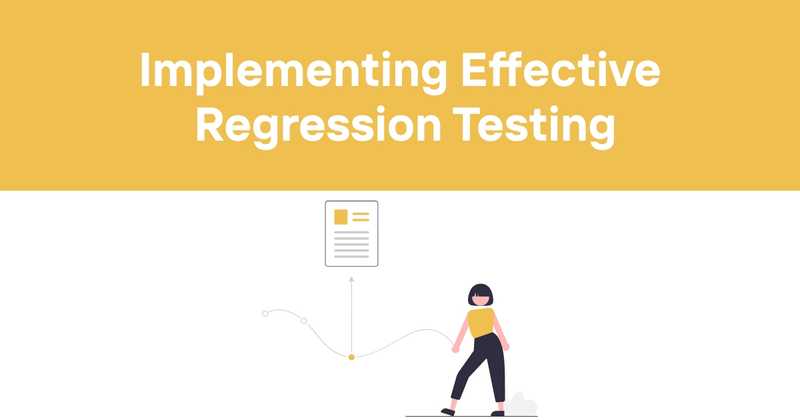Implementing Effective Regression Testing
Table of Contents
- Introduction
- What is Regression Testing?
- Why is Regression Testing Important?
- Types of Regression Testing
- Regression Testing Techniques
- When to Perform Regression Testing
- Challenges in Regression Testing
- Best Practices for Effective Regression Testing
- Regression Testing Tools
- Automating Regression Tests
- Integrating Regression Testing into CI/CD
- Measuring the Success of Regression Testing
- Regression Testing in Agile Environments
- Common Pitfalls to Avoid
- Conclusion
Introduction
As a software developer, I've learned that building robust, reliable software isn't just about writing new code - it's also about making sure the existing stuff doesn't break when we tinker with it. That's where regression testing comes in. It's like a safety net for our code, catching issues before they snowball into major problems.
In this article, we'll dive into the nuts and bolts of regression testing. I'll share some insights from my own experiences, and we'll explore why it's crucial, how to do it effectively, and some tricks to make it less of a headache. So, grab a coffee (or your beverage of choice), and let's get started!
What is Regression Testing?
Regression testing is the process of re-running functional and non-functional tests to ensure that previously developed and tested software still performs correctly after a change. These changes might include enhancements, patches, configuration changes, or even updates to related software components.
Think of regression testing as a health check-up for your code. Just like how we humans need regular check-ups to catch any health issues early, our software needs regression tests to catch any unintended side effects of changes we make.
I remember a time when I skipped regression testing after making what I thought was a tiny change to a module. Big mistake! That "tiny" change ended up breaking a critical feature in production. Lesson learned: never underestimate the importance of regression testing, no matter how small the change seems.
Why is Regression Testing Important?
-
Maintains software quality: It ensures that new changes don't negatively impact existing functionality.
-
Catches unexpected side effects: Sometimes, changes in one part of the code can have unforeseen consequences in other areas.
-
Saves time and resources: While it might seem time-consuming upfront, regression testing can prevent costly fixes down the line.
-
Builds confidence: It gives developers and stakeholders confidence in the stability of the software.
-
Supports continuous integration: In modern development practices, regression tests are crucial for ensuring smooth integration of new code.
Types of Regression Testing
There are several types of regression testing, each serving a specific purpose:
-
Unit Regression: This focuses on testing individual units or components of the code.
-
Partial Regression: This involves testing affected parts of the code after a change.
-
Complete Regression: This is a comprehensive test of the entire system.
-
Smoke Regression: A subset of test cases that cover the most important functionality.
-
Sanity Regression: A narrow regression test that focuses on particular component(s) to verify functionality.
In my experience, the type of regression testing you choose often depends on the scale of changes and the project timeline. For minor updates, I usually go with partial or smoke regression. For major releases, a complete regression is often necessary.
Regression Testing Techniques
Let's look at some common techniques for regression testing:
-
Retest All: Run all existing test cases. It's thorough but time-consuming.
-
Regression Test Selection: Only select and test the affected parts of the application.
-
Test Case Prioritization: Prioritize test cases based on business impact, critical functionalities, or frequently used features.
-
Hybrid: A combination of other techniques, tailored to the specific needs of the project.
Here's a table comparing these techniques:
| Technique | Pros | Cons | Best Used When |
|---|---|---|---|
| Retest All | Thorough, Catches all regressions | Time-consuming, Resource-intensive | Major releases, Critical systems |
| Regression Test Selection | Saves time, Focuses on impacted areas | May miss some regressions | Minor updates, Time constraints |
| Test Case Prioritization | Efficient use of time, Focuses on critical areas | May miss low-priority regressions | Limited testing time, Clear feature priorities |
| Hybrid | Flexible, Can be optimized for specific needs | Requires careful planning | Complex projects with varying needs |
I've found that a hybrid approach often works best. It allows you to be thorough where it matters most, while still keeping the testing process manageable.
When to Perform Regression Testing
Regression testing should be performed:
- After every bug fix
- When new features are added
- During software updates or patches
- When there are changes in the environment (e.g., database, server)
- Before major releases
One thing I've learned is that it's better to run regression tests too often than not often enough. I once worked on a project where we only did regression testing before major releases. We ended up with a pile of small bugs that were hard to trace back to their origin. Now, I make sure to run at least some level of regression testing after every significant change.
Challenges in Regression Testing
Regression testing isn't without its challenges. Here are some common ones:
-
Time-consuming: As the software grows, so does the number of test cases.
-
Resource-intensive: It often requires significant computational resources.
-
Maintenance of test cases: Keeping test cases up-to-date can be a challenge.
-
Identifying the right tests: Knowing which tests to run can be tricky.
-
Handling false positives: Sometimes tests fail due to changes in the environment rather than actual bugs.
-
Dealing with flaky tests: Tests that sometimes pass and sometimes fail can be frustrating.
I've grappled with all of these at some point. The key is to stay organized, keep your test suite lean and relevant, and leverage automation where possible.
Best Practices for Effective Regression Testing
Based on my experience, here are some best practices that can help make regression testing more effective:
-
Maintain a robust test suite: Regularly update your test cases to reflect the current state of the application.
-
Prioritize test cases: Focus on critical functionalities and areas prone to bugs.
-
Automate where possible: This saves time and reduces human error.
-
Use version control for test scripts: This helps track changes and rollback if needed.
-
Schedule regular regression testing: Don't wait for major releases.
-
Monitor and analyze test results: Look for patterns in failures to identify problem areas.
-
Keep test environments consistent: Ensure your test environment mirrors production as closely as possible.
-
Involve the right people: Make sure developers, testers, and business analysts are all in the loop.
-
Document everything: Clear documentation helps in maintaining and updating tests.
-
Use data-driven testing: This allows you to run the same test with different data sets.
Remember, these aren't hard and fast rules. Adapt them to fit your project's needs. What works for one team might not work for another.
Regression Testing Tools
There are numerous tools available for regression testing. Here are some popular ones:
- Selenium: Great for web application testing.
- JUnit: Widely used for Java applications.
- TestNG: Another popular choice for Java, with some additional features over JUnit.
- PyTest: A powerful testing framework for Python.
- Cucumber: Supports Behavior Driven Development (BDD).
- Jenkins: Useful for continuous integration and automated testing.
- Travis CI: Another CI tool that integrates well with GitHub.
- JIRA: While primarily a project management tool, it has features that support test case management.
I've used most of these at some point, and they all have their strengths. Selenium is my go-to for web apps, while PyTest is great for Python projects. The key is to choose a tool that integrates well with your development environment and meets your specific needs.
Automating Regression Tests
Automation is a game-changer when it comes to regression testing. Here's why:
- Saves time: Automated tests can run much faster than manual tests.
- Improves accuracy: Eliminates human error in test execution.
- Increases test coverage: You can run more tests in less time.
- Supports continuous integration: Automated tests can be easily integrated into CI/CD pipelines.
However, automation isn't a silver bullet. It requires initial setup time and ongoing maintenance. Also, not all tests can (or should) be automated.
When deciding what to automate, consider:
- Tests that are run frequently
- Tests for critical functionality
- Tests that are time-consuming or error-prone when done manually
- Tests that involve large amounts of data
I once worked on a project where we went overboard with automation, trying to automate every single test. We ended up spending more time maintaining our automated tests than actually developing the product. Now, I aim for a balanced approach, automating the most critical and repetitive tests while keeping some tests manual.
Integrating Regression Testing into CI/CD
Continuous Integration and Continuous Deployment (CI/CD) have become standard practices in software development. Integrating regression testing into your CI/CD pipeline can significantly improve your software quality and release process.
Here's a basic workflow:
- Developer pushes code to the repository
- CI server detects the change and triggers a build
- Automated unit tests run
- If unit tests pass, integration tests run
- If integration tests pass, automated regression tests run
- If all tests pass, the code can be deployed to staging/production
This approach catches issues early in the development cycle, making them easier and cheaper to fix.
To implement this, you'll need:
- A version control system (like Git)
- A CI server (like Jenkins or Travis CI)
- Automated tests
- A deployment system
Remember, the goal is to catch issues as early as possible. Don't wait until the end of a sprint or release cycle to run your regression tests.
Measuring the Success of Regression Testing
How do you know if your regression testing efforts are paying off? Here are some metrics you can track:
- Defect detection rate: The number of defects found during regression testing.
- Test case effectiveness: Which test cases are finding the most bugs?
- Regression testing time: How long does it take to complete a regression testing cycle?
- Automation coverage: What percentage of your tests are automated?
- Defect escape rate: How many bugs are making it to production?
I like to keep a dashboard with these metrics. It helps me identify trends and areas for improvement. For instance, if I see the regression testing time increasing sprint over sprint, it might be time to optimize our test suite or invest in faster hardware.
Regression Testing in Agile Environments
Agile development presents unique challenges for regression testing. With frequent iterations and constant changes, how do you ensure nothing breaks?
Here are some strategies I've found effective:
- Continuous regression testing: Run a subset of critical regression tests after every build.
- Risk-based testing: Focus on areas that have changed or are impacted by changes.
- Automated smoke tests: Quick tests to check core functionality.
- Parallel testing: Run tests concurrently to save time.
- Test data management: Maintain good test data to support frequent testing.
In Agile environments, it's crucial to strike a balance between thoroughness and speed. You can't test everything all the time, so you need to be smart about what you test and when.
Common Pitfalls to Avoid
Over the years, I've seen (and, admittedly, made) quite a few mistakes when it comes to regression testing. Here are some common pitfalls to watch out for:
- Neglecting test case maintenance: As your software evolves, so should your test cases.
- Ignoring failed tests: A failed test is trying to tell you something. Don't ignore it!
- Over-reliance on automation: Remember, automation is a tool, not a replacement for human insight.
- Testing in isolation: Make sure your regression tests cover integration points between components.
- Lack of variety in test data: Using the same test data every time can miss edge cases.
- Not involving the right stakeholders: Regression testing isn't just a QA activity. Developers and business analysts should be involved too.
- Forgetting about performance: Regression testing should cover performance as well as functionality.
I once worked on a project where we had a suite of beautifully automated regression tests. We were pretty proud of ourselves - until we realized we'd been using the same test data for months. Our tests were passing with flying colors, but they weren't catching new edge cases introduced by recent feature additions. Lesson learned: regularly review and update your test data!
Conclusion
Regression testing is a critical part of the software development process. It helps ensure that new changes don't break existing functionality, saving time, resources, and headaches in the long run. While it can be challenging, especially as projects grow in size and complexity, the benefits far outweigh the costs.
Remember, there's no one-size-fits-all approach to regression testing. What works for one project might not work for another. The key is to understand the principles, start with best practices, and then adapt your approach based on your specific needs and constraints.
As we wrap up, I want to mention a tool that can be incredibly helpful in your overall testing strategy: Odown. While it's not specifically a regression testing tool, Odown's website uptime monitoring can complement your regression testing efforts beautifully.
Odown provides real-time monitoring for websites and APIs, which can help you quickly identify if a new deployment has caused any availability issues. Its public status pages can keep your team and users informed about the current state of your systems. And with SSL certificate monitoring, you can ensure that your security measures remain intact after changes.
By combining thorough regression testing with Odown's monitoring capabilities, you can create a robust system for catching issues both during development and in production. This comprehensive approach can significantly improve your software's reliability and your users' experience.
Remember, the goal of all this testing and monitoring is to deliver high-quality software that meets user needs. Keep that in mind, and you'll be on the right track. Happy testing!



